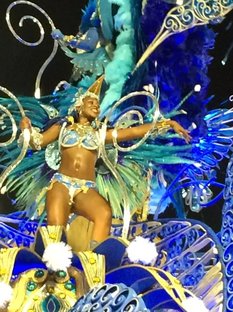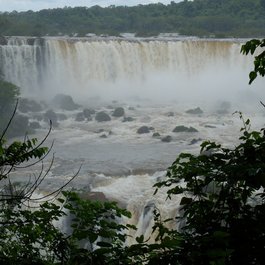 How often does fear, real or imagined, influence the choices you make? Prevent you from doing things you later regret? A distressing emotion, fear can sometimes override common sense. Other times it might save your life. Knowing the difference is key. Watching the televised opening of the 2016 Olympics in Rio de Janeiro last summer brought it home – Brazil’s spectacular natural and man-made wonders, diverse ethnicities, Brazilians’ exuberance, passion for partying despite economic and political challenges – and to think we nearly missed experiencing these because of the fear factor. Last February, bombarded by a flurry of headlines in local and national newspapers screaming Zika in Brazil and warnings by friends of likely crimnal encounters, my husband Frank and I flew to Rio de Janeiro for Carnival. Zika, a virus carried by an infected Aedes mosquito, is linked to microcephaly in newborns whose mothers, when pregnant, are bitten by the infected mosquito. In my seventies, I wasn’t about to get pregnant nor was Frank a likely Zika victim. Nonetheless, we packed a couple tubes of DEET insect repellent and left showy jewelry at home. “We don’t wear repellent,” our guide volunteered our first day in Rio de Janeiro. “Rio isn’t where Zika mosquitos are.” Great news, we thought, knowing Rio would be the site for golf and other sporting events in the 2016 Summer Olympics. Who knew that four world-famous male golfers, citing Zika fear, would opt against going to Brazil to compete in an event not played in the Olympics since 1904? Do they regret their decision? Mingling shoulder-to-shoulder with Brazilians on crowded subways from dazzling Copacabana Beach to the Hippi Market in Ipanema and on mountain-scaling funiculars to view Christ the Redeemer up close and Rio from on high, no one picked our pockets. Even in the Sambadrome arena with some 90,000 spectators witnessing samba competitions by schools of 3 – 4,000 costumed singers and dancers, some on floats two- and three-stories high, we had no unsavory experiences. Caught up in the jubilation of the crowd, we cheered – dancing in place – as each school paraded the length of the arena, about a half-mile, vying for the $5 milliion first prize. We lasted until 3 a.m., seeing three of six finalists. The entire competition runs from 9:30 p.m. to 6 a.m. on successive nights. Taken by our guide to Rocinah, a “safe” favela, we admired the clean streets and colorful slum houses dotting hillsides overlooking the Atlantic Ocean. Driving back down to the center of Rio, we stopped at a Brazilian steakhouse for succulent cuts of meat barbecued, in old gaucho tradition, on an open fire – an over-the-top experience for ambivalent carnivores. From Rio we flew southwest to Iguacu Falls to see the magnificent spectacle of 275 waterfalls creating thunderous, wondrous curtains of white that stretch nearly two miles wide and 200 or more feet high. Their source, the Iguacu River, forms the boundary between Brazil and Argentina. Wooden stairways brought us within arms-length of the rumbling falls, allowing us to sense the power of falling water, not a few gallons but millions of barrels. Still, no mosquitos. Up north in Manaus, awaiting a riverboat that would take us onto the Amazon and into the rain forest, we walked through the Adolpho Lisboa Municpal Market, a cast-iron replica in miniature of Paris’s Les Halles market building. Later, we ventured into the city’s famed opera house, the opulent Teatro Amazonas, where the Amazonas Philharmonic Orchestra was rehearsing Beethoven’s Ninth. Comfortably seated inside this Renaissance jewel built in the late 1800s, I let the music fill my body while my eyes feasted on tiers of gold-leafed columns, chandeliers (198 imported from Italy including some of Murano glass) and the ornate ceiling of painted panels depicting music, dance and drama. Only after leaving the opera house did I focus on its exterior – walls painted a dusty rose, accented by white columns, and a dome covered with thousands of ceramic tiles painted the colors of Brazil’s national flag – green, yellow, blue and a little white. We had expected Manaus to be a village dominated by the opera house built when fortunes were made in rubber. Instead, we found a city teeming with some two million inhabitants and an ever-growing presence of high-tech companies.  Our cruise on the Amazon and trek through the rain forest led by an indigenous tribesman who showed us how to survive in the forest left me with one regret. I’d hoped to see hundreds of wild birds, including toucans noted for their large colorful bills, but the birds were few and the only toucan I saw was in the Manaus zoo. After two weeks in Brazil, I’m hard-pressed to describe the looks of a Brazilian. Descendants of early settlers and post-colonial immigrants – Portuguese, Italian, Spaniards and Germans with large numbers of Japanese, Poles and Lebanese – African slaves and Brazil’s indigenous peoples, they, like those of us in the United States, are not a homogeneous lot. We were told that the largest Japanese community outside Japan – some 2 million -- lives in Sao Paulo. Our last day in Manaus a mosquito flitted by while I was eyeing souvenirs in a shop in our hotel complex. Wearing repellent, I was relatively fearless. According to one authority, our chances of being killed by a car in the U.S. are 17,400 times greater than contracting Zika from a mosquito in Brazil. If we’d given way to unexamined fear, we might never have experienced the richness of Brazil and Brazilians’ unabashed passions.
2 Comments
Leave a Reply. |
Author BLOG
I'm Shirley Melis. You may know me as Shirley M. Nagelschmidt, Shirley M. Bessey and now, Shirley M. Hirsch. Each reflects a particular phase of my life. Banged-Up Heart is a slice of my life's journey and in telling my story, I'm giving voice to my long silent "M" by reclaiming my maiden name, Shirley Melis. Archives
January 2024
Categories
All
|

 RSS Feed
RSS Feed